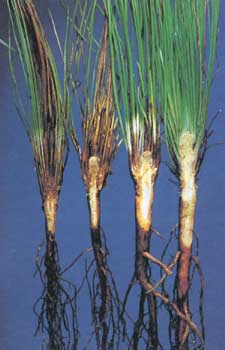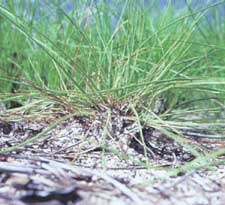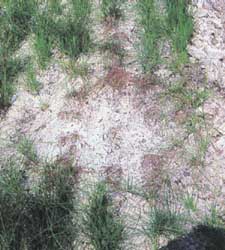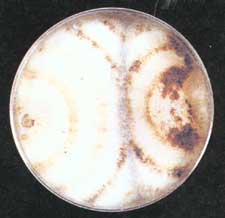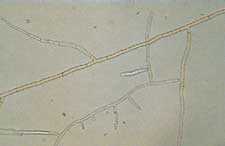Rhizoctonia Blight of Longleaf PineJames T. English - College of Agricultural and Environmental Sciences, University of California, Davis, Davis, CA, and Cordell C.E., Anderson R.L., Hoffard W.H., Landis T.D., Smith R.S. Jr., Toko H.V., 1989. Forest Nursery Pests. USDA Forest Service, Agriculture Handbook No. 680, 184 pp. Hosts Rhizoctonia blight affects almost all conifers, but longleaf pines are particularly susceptible because the seedlings grow as grass does, close to the soil. The blight is caused by species of Rhizoctonia (R. solani or binculeate forms of Rhizoctonia with sexual states belonging to the genera Thanatephorus or Ceratobasidium, respectively). Few hardwoods are susceptible. Distribution Rhizoctonia blight has been reported on bareroot stock in North Carolina, South Carolina, Mississippi, and Florida. It is a potential problem wherever nurseries grow bareroot longleaf pine. Damage Rhizoctonia blight can cause significant mortality of longleaf pine in nursery beds. Its effect on field performance of outplanted stock is unknown.
In nurseries, infected seedlings usually occur in groups of various sizes. These infection centers typically consist of several dead seedlings surrounded by seedlings with different degrees of discoloration (fig. 19-3).
Biology How Rhizoctonia spp. infest a nursery is uncertain: sources of inoculum may include contaminated seed, airborne basidiospores, infested soil carried on machinery, or natural mulching material, such as pine straw. Rhizoctonia spp. probably over-winter as sclerotia, either within plant debris or in the soil. Control Prevention - Use only recently collected, clean seed for sowing. When feasible, sow longleaf pine seed in the fall. Losses in fall-sown longleaf pine have been appreciably less than when seedlings are sown in the spring. Cultural - Avoid the movement of infested soils within nurseries on machinery or hand tools. Recent field trials have shown that the incidence of Rhizoctonia blight may be reduced by using hardwood chips rather than pine straw as mulch. Maintain soil pH below 6.0 to minimize activity of the pathogens. Rhizoctonia blight appears to develop more rapidly in neutral to alkaline soils. Chemical - Fumigate nursery beds with methyl bromide, preferably mixed with chloropicrin. Fumigate with methyl bromide all natural mulching material, such as pine straw, because Rhizoctonia spp. may exist saprophytically in this material. Selected References Davis, W.C. 1941. Damping-off of longleaf pine. Phytopathology. 31: 1011-1016. English. J.T.; Ploetz, R.C.: Barnard. E.L. 1986. Seedling blight of longleaf pine caused by a binucleate Rhizoctonia solani-like fungus. Plant Disease. 70: 148- 150. Gilly, S.P.; Barnard. EL.; Schroeder. R.A. 1985. Field trials for the control of Rhizoctonia blight of longleaf pine seedlings: effects of seedbed planting densities, fungicides, and mulches. In: South, D.B., ed. Proceedings of the international symposium on nursery management practices for the southern pines; 1985 August. 4-5; Montgomery, AL. Montgomery. AL: Alabama Agriculture Experiment Station. Auburn University. and the International Union of Forest Research Organizations: Parmeter. J.R. Jr., ed. 1970. Rhizoctonia solani, biology and pathology. Berkeley: University of California Press. 255 p. |
Forest Pests: Insects, Diseases & Other Damage Agents |

|
|
